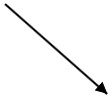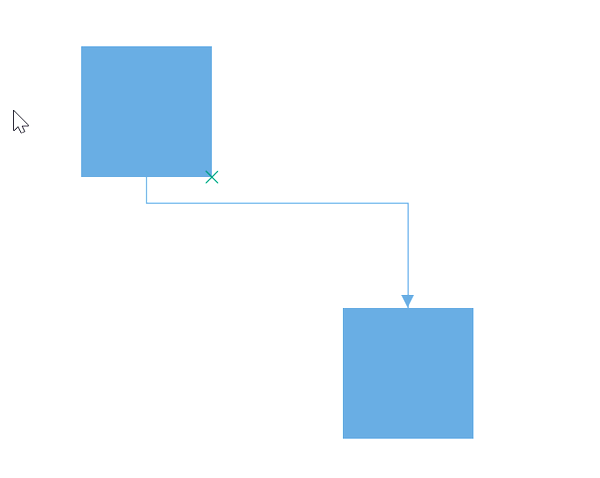Tools in WPF Diagram (SfDiagram)
24 Jan 202513 minutes to read
Tool Selection
There are some functionalities that can be achieved by clicking and dragging on the Diagram surface. They are as follows.
- Draw selection rectangle – MultipleSelect tool
- Pan the Diagram – Zoom pan
- Draw Nodes/Connectors – ContinuousDraw / DrawOnce
As all the three behaviors are completely different, You can achieve only one behavior at a time based on the tool that you choose. When more than one of those are applied, a tool is activated based on the precedence given in the following table.
| Tools | Description |
|---|---|
| ContinuesDraw | Allows you to draw the Nodes or Connectors continuously. Once it is activated, you cannot perform any other interaction in the Diagram. |
| DrawOnce | Allows you to draw single Node or Connector. Once you complete the DrawOnce action, SingleSelect and MultipleSelect tools are automatically enabled. |
| ZoomPan | Allows you to pan the Diagram. When you enable both the SingleSelect and ZoomPan tools, you can perform the basic interaction as the cursor hovers Node/Connector. Panning is enebled when cursor hovers the Diagram. |
| MultipleSelect | Allows you to select multiple Nodes and Connectors. When you enable both the MultipleSelect and ZoomPan tools, cursor hovers the Diagram. When panning is enabled, you cannot select multiple Nodes. |
| SingleSelect | Allows you to select individual or Connectors. |
| None | Disables all tools. |
You can set the desired tool to the Tool property of the Diagram. The following code illustrates how to enable single/multiple tools.
//To Enable Single Tool
diagram.Tool = Tool.SingleSelect;
//To Enable multiple tools
diagram.Tool = Tool.SingleSelect | Tool.ZoomPan;NOTE
Drawing Tools
DrawingTool allow you to draw any kind of node/connector during runtime by clicking and dragging on the Diagram page.
Shapes
To draw a shape, You have to activate the drawing tool by using the Tool property and you need to set the event for GetDrawType.
<Style TargetType="Path" x:Key="shapestyle">
<Setter Property="Fill" Value="#fbe172"/>
<Setter Property="Stroke" Value="Black"/>
<Setter Property="Stretch" Value="Fill"/>
</Style>
<Style TargetType="{x:Type diagram:Node}">
<Setter Property="Shape" Value="M13.560 67.524 L 21.941 41.731 L 0.000 25.790 L
27.120 25.790 L 35.501 0.000 L 43.882 25.790 L 71.000
25.790 L 49.061 41.731 L 57.441 67.524 L 35.501
51.583 z"/>
<Setter Property="ShapeStyle" Value="{StaticResource shapestyle}"/>
</Style>//GetDrawType event is used to specify which item have to be drawn by the user.
(diagram.Info as IGraphInfo).GetDrawType += MainWindow_GetDrawType;
diagram.DrawingTool = DrawingTool.Node;
diagram.Tool = Tool.ContinuesDraw;
private void MainWindow_GetDrawType(object sender, DrawTypeEventArgs args)
{
args.DrawItem = new TextBlock()
{
Text="Path",
HorizontalAlignment = HorizontalAlignment.Center,
VerticalAlignment = VerticalAlignment.Center
};
}
-
GetDrawTypeevent will invoke when start drawing and get DrawItem (i.e which item you will draw) from the user.To explore about arguments, please refer to the DrawTypeEventArgs .
Text
Diagram allows you to create a text Node as soon as you click on the Diagram page. The following code illustrates how to draw a text.
<Syncfusion:SfDiagram x:Name="diagram" Tool="ContinuesDraw" DrawingTool="TextNode">
<Syncfusion:SfDiagram.Nodes>
<Syncfusion:NodeCollection />
</Syncfusion:SfDiagram.Nodes>
<Syncfusion:SfDiagram.Connectors>
<Syncfusion:ConnectorCollection />
</Syncfusion:SfDiagram.Connectors>
</Syncfusion:SfDiagram>diagram.DrawingTool = DrawingTool.TextNode;
diagram.Tool = Tool.ContinuesDraw;Connectors
To draw Connectors, you have to set the Connector to DrawingTool property. The DrawingTool can be activated by using the Tool property as shown. The following code example illustrates how to draw a straight line Connector.
<Style x:Key="decoratorstyle" TargetType="Path">
<Setter Property="Stroke" Value="Black" />
<Setter Property="Fill" Value="Black" />
<Setter Property="StrokeThickness" Value="1" />
</Style>
<Style TargetType="Path" x:Key="connectorstyle">
<Setter Property="Stroke" Value="Black"></Setter>
<Setter Property="StrokeThickness" Value="2"></Setter>
</Style>
<Style TargetType="{x:Type diagram:Connector}">
<Setter Property="TargetDecoratorStyle" Value="{StaticResource decoratorstyle1}"/>
<Setter Property="ConnectorGeometryStyle" Value="{StaticResource connectorstyle}"/>
</Style>diagram.DrawingTool = DrawingTool.Connector;
diagram.Tool = Tool.DrawOnce;
Diagram allows you to establish connection with Node/Port as soon as you click on the Node/Port.
-
ObjectDrawnevent will invoke with drawing state.To explore about arguments, please refer to the ObjectDrawnEventArgs .
FreeHand drawing
Free hand connections will be drawn by using DrawingTool property.
<Syncfusion:SfDiagram x:Name="diagram" Tool="ContinuesDraw" DrawingTool="FreeHand">
<Syncfusion:SfDiagram.Nodes>
<Syncfusion:NodeCollection />
</Syncfusion:SfDiagram.Nodes>
<Syncfusion:SfDiagram.Connectors>
<Syncfusion:ConnectorCollection />
</Syncfusion:SfDiagram.Connectors>
</Syncfusion:SfDiagram>// Enable the FreeHand drawing
diagram.DrawingTool = DrawingTool.FreeHand;
FreeFormEvent will notify the current drawing Connector and drawing State in FreeFormDrawingEventArgs.
Ellipse
Diagram allows you to create a ellipse shaped node as soon as you click and drag on the Diagram page. The following code illustrates how to draw an ellipse shaped node.
<Syncfusion:SfDiagram x:Name="diagram" Tool="ContinuesDraw" DrawingTool="Ellipse">
<Syncfusion:SfDiagram.Nodes>
<Syncfusion:NodeCollection />
</Syncfusion:SfDiagram.Nodes>
<Syncfusion:SfDiagram.Connectors>
<Syncfusion:ConnectorCollection />
</Syncfusion:SfDiagram.Connectors>
</Syncfusion:SfDiagram>diagram.DrawingTool = DrawingTool.Ellipse;
diagram.Tool = Tool.ContinuesDraw;Rectangle
Diagram allows you to create a rectangle shaped node as soon as you click and drag on the Diagram page. The following code illustrates how to draw a rectangle shaped node.
<Syncfusion:SfDiagram x:Name="diagram" Tool="ContinuesDraw" DrawingTool="Rectangle">
<Syncfusion:SfDiagram.Nodes>
<Syncfusion:NodeCollection />
</Syncfusion:SfDiagram.Nodes>
<Syncfusion:SfDiagram.Connectors>
<Syncfusion:ConnectorCollection />
</Syncfusion:SfDiagram.Connectors>
</Syncfusion:SfDiagram>diagram.DrawingTool = DrawingTool.Rectangle;
diagram.Tool = Tool.ContinuesDraw;How to override the default tool of diagram elements
Each objects in diagram control have deafult actions while interact on them. Those default actions can be customized by overriding the virtual method SetTool of the SfDiagram class. The SetTool method takes the SetToolArgs as an argument that is used to know the objects under the mouse when modifying the tools of them.
-
Source – To know the object on which item the mouse is interacting.
-
Action - To customize the tools of the diagram object.
<!--Create new diagram for custom diagram class-->
<local:CustomClass PortVisibility="Visible" x:Name="diagram"/>//Create custom class of SfDiagram to override the tools.
public class CustomClass:SfDiagram
{
//Override method to customize the default tools of diagram objects
protected override void SetTool(SetToolArgs args)
{
if (args.Source is INode)
{
args.Action = ActiveTool.Pan;
}
else if (args.Source is IConnector)
{
args.Action = ActiveTool.Draw;
}
else if (args.Source is IPort)
{
args.Action = ActiveTool.Drag;
}
else
{
base.SetTool(args);
}
}
}
NOTE
How to override the default cursors while interaction
While mouse hovers on the diagramming objects, different cursors will be appearing on each object for different actions. For example, when we mouse hover on the rotator thumb, then rotator cursor will be shown.

These cursors can be customized by overriding the virtual method SetCursor() of the SfDiagram class. The SetCursor() method takes the SetCursorArgs as an argument that is used to know the objects under the mouse cursor when modifying the cursors of them.
-
Action – To know the action tool of the element.
-
ControlPointType – To know the control point of the object.
-
Cursor – To customize the cursor of the object.
-
Source – To know the object on which item the mouse is interacting.
-
SourceType – To know the parent element of the object.
<!--Create new diagram for custom diagram class-->
<local:CustomClass PortVisibility="Visible" x:Name="diagram"/>//Create custom class of SfDiagram to override the cursor.
public class CustomClass:SfDiagram
{
//Override method to customize the default cursors of diagram objects
protected override void SetCursor(SetCursorArgs args)
{
if (args.Source is INode)
{
args.Cursor = Cursors.No;
}
else if (args.Source is IConnector)
{
args.Cursor = Cursors.Hand;
}
else if (args.Source is IPort)
{
args.Cursor = Cursors.SizeAll;
}
else
{
base.SetCursor(args);
}
}
}
NOTE
See Also
How to override the default cursors while interaction?
How to switch between tools at runtime through the SetTool?
How to create port at runtime through set tool?
How to Obtain the Polyline Connector Completed status in WPF Diagram?